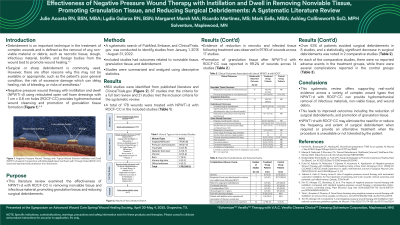Evidence-Based Practice
(EBP-001) Effectiveness of Negative Pressure Wound Therapy with Instillation and Dwell in Removing Nonviable Tissue, Promoting Granulation Tissue, and Reducing Surgical Debridements: A Systematic Literature Review

Methods: A systematic search was conducted utilizing PubMed, Embase, and ClinicalTrials.gov to identify studies conducted from January 1, 2015 – August 31, 2022. Study outcomes related to nonviable tissue, granulation tissue, and debridement were summarized and analyzed using descriptive statistics.
Results:
Twenty-one studies including 178 patients who received NPWTi-d with ROCF-CC were included. Evidence of reduction in necrotic and infected tissue following treatment was observed in 97.9% of wounds across 17 studies. Formation of granulation tissue after NPWTi-d with ROCF-CC was reported in 99.2% of wounds across 14 studies. Over 63% of patients avoided surgical debridements in 8 studies, and a statistically significant decrease in surgical debridements was noted in 2 comparative studies.
Discussion:
This systematic review provides real-world evidence demonstrating the effectiveness of NPWTi-d with ROCF-CC in the hydromechanical removal of infectious materials, non-viable tissue, and wound debris, reduction of surgical debridements, and promotion of granulation tissue. NPWTi-d with ROCF-CC may eliminate the need for or reduce the frequency and extent of surgical debridement when required or provide an alternative treatment when the procedure is unavailable or not tolerated by the patient.

.jpg)
